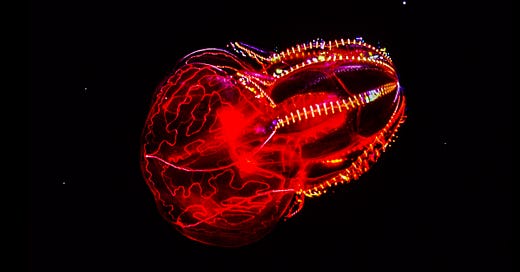Bloody Belly Comb Jelly
When an infinite number of monkeys type on a infinite number of keyboards, the above title is bound to be produced. Or… one could just be talking about a deep sea creature aka Lampocteis cruentiventer.
Monterrey Bay Aquarium has a great video on this creature:
So A) Where does it live and B) Why is the belly blood red? Seems the answer to both are inextricably linked. Despite being called a jelly — it is not a true jellyfish.
Comb jellies are a group of marine invertebrates technically known as ctenophores that are not true jellyfish despite their resemblance to these creatures.
All comb jellies have eight bands or rows of tiny hair-like structures called cilia, which beat continuously, propelling the animal through the water. When light strikes these bands of moving cilia, it diffracts and refracts in such a way that it produces a shimmering rainbow of colors.
Ctenophores lack the stinging cells that are characteristic of the group of animals called Cnidaria—which includes true jellyfish and corals, along others—and have the largest cilia known to science.1
This creature from the deep can live as far down as 9,000 ft. This covers a couple of ocean layers:
Mesopelagic – twilight zone – 660 to 3300 ft. Many organisms that live in this zone are bioluminescent.
Bathypelagic – midnight zone – 3300 to 13000 ft. Pitch black. No plants. Occasional bioluminescent organisms. This is where sperm whale hunt giant squid.
Down where it is very, very dark and scary, one does not want a predator sneaking up on one. Especially after one has just had lunch. And what do the comb jellies eat? Glow in the dark thingies. How would you like everyone seeing what you ate for lunch? No thank you sir… Comb Jellies have a red belly because that color is pretty much invisible that far down. Red is the first wavelength of light absorbed as you descend into the deep sea. So in these regions, bloody-belly comb jellies appear black, rendering them virtually invisible given the darkness of their surroundings.
Fortunately for humans, these little guys max out at about 6 inches in length… Whew!
https://www.newsweek.com/gorgeous-deep-sea-jelly-glows-blood-red-hide-meal-predators-1754317



